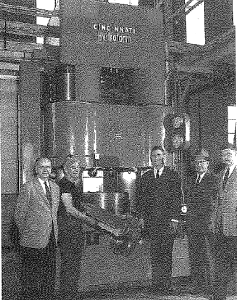History of Hydroforming
Hydroforming
Hydroforming, the alternative to conventional matched die metal forming, is a cost-effective forming solution, especially for lower volume production or parts with asymmetrical or irregular contours.

Hydroforming is often mentioned along with tube hydroforming and sheet metal hydroforming, all of which utilize the principles of fluid dynamics to form metal parts. Tube hydroforming, first referenced from an early 1900’s process, has made its name in the auto industry. Sheet metal hydroforming, likewise, has found its place in auto-body structures (H. Singh, Fundamentals of Hydroforming, 2003, Society of Manufacturing Engineers, Library of Congress Catalog Card Number 2003105327).
The following is a brief history of the hydroforming process which developed in a different direction to produce parts outside the auto industry and several of the advantages offered by this unique forming process.
Cincinnati Milling Machine Company
The Cincinnati Milling Machine Company was incorporated in 1889, founded by Frederick V. Geiger and Fred Holz. By 1890, the company was selling its products—various machines and tools— across the US and Europe. In 1905, the company outgrew its original building and by the 1930s, the company was the largest producer of machine tools in the world.
In the early 1950s, the company formed a division that produced its first metal forming machine—the hydroform. “It was used to ‘deep draw’ parts such as lighting reflectors and gear-case covers. Its unique design employed a rubber diaphragm backed by oil pressure instead of the traditional female die. For comparatively short production runs, it was very
economical because it eliminated the need for costly matched die sets” (1884 Cincinnati Milacron 1984 Finding Better ways, Library of Congress Catalog Number 84-72726). Some sources say that the Cincinnati Milling Machine Company only manufactured 712 of these machines and as few as 50 of the 32” Hydroforms.
The manufacture of Cincinnati hydroforms continued into the 1970’s when the company changed its name to Cincinnati Milacron Inc., now known simply as Milacron, Inc. A 1970 sales brochure described the machine as “designed specifically for medium production deep drawing at a low initial investment cost.
By 1975 the Verson Allsteel Press Company in Chicago acquired the Milacron hydroform business and made improvements in forming capability and speed. The improved machines carried the name Verson Hydroform. There do not appear to have been more new machines manufactured; the manufacture—but not the use of– hydroform machines of this type had come to the end of the line.
Hydroforming and Jones Metal
In 1956, Jones Metal began searching for new technology to replace their nearly obsolete draw presses and to leapfrog metal stamping companies. In the process they discovered hydroforming. Jones Metal purchased their first hydroforming machine, a brand new 32” Cincinnati hydroform, in 1957, and the Jones Metal history of hydroforming excellence began.
Now, Jones Metal has 11 Cincinnati Hydroform machines, capable of up to 32″ diameter x 12″ deep capacity, and is currently the largest hydroforming contract manufacturer in the USA
with three 32” presses, four 25” presses, two 20” presses, and two 15” presses.
Benefits of Hydroforming
Hydroforming presents several key benefits. For example, hardened tool steels are rarely required in the hydroforming process. Most draw rings and punches are made of cast iron, which is a cost-effective and easily machined material with a very long tool life.
Tool changes are fast: tools are mounted very quickly, are self-aligning and self-centering, making setups quick and easy.
The hydroforming method is extremely precise. Depending on the material and shape, inside measurements can be held to ±.005” or ±.002.”
Using the hydroforming process, there are fewer operations required. While a part may require two or three operations on a conventional press, many parts can be formed on one hydroforming operation.
Recommended Resources from the Hydroforming Experts
Check out our latest video featuring
a deep dive on hydroforming by Jones Metal Products.
Related Links
